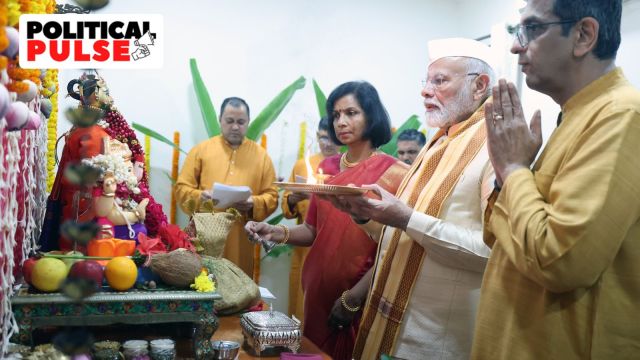by JAWED NAQVI

A story one heard from an associate of Urdu poet Firaq Gorakhpuri possibly frames the debate nicely about India’s chief justice, D.Y. Chandrachud, who has been facing adverse comments over a TV clip that showed him with Prime Minister Narendra Modi participating in a private puja last week. The CJI holds the ritual annually at his home to celebrate Lord Ganesh. The problem, it seems, is that this time Modi was his guest, and in full public view.
There’s nothing seriously wrong with two men performing prayers together. The point is who are we talking about.
The story goes that a friend asked Firaq to evaluate Harvansh Rai Bachchan’s popular Hindi poem Madhushala, or ‘The Tavern’.
Bachchan’s poem is often likened to 11th-century Persian poet Omar Khayyam’s famous tribute to wine. The theme of the goblet and the flask and the saqi permeates Urdu poetry too, both as a metaphor of resistance against the ubiquitous religious vigilante and as a magic potion that few Western poets (other than possibly Coleridge) have cared to indulge.
Firaq’s response to Bachchan’s long poem was scalding. “When Khayyam and his ilk write about wine, they celebrate the implicit romance of mocking the naysayer. In our [Hindu] culture, there’s no limit to the amount we can drink. Therefore, Ghalib doesn’t sound like a drunkard applauding the tavern, which cannot be said about the author of Madhushala.”
In other words, Neruda or Elliot or Nirala would not be able to carry the theme of the goblet with the ready ease that Faiz or Majaaz could. It’s not always easy to appreciate what is being said without knowing who is saying it.
The prime minister and the chief justice — both Hindu men and both representing the secular Indian state at the highest levels — can perhaps try to see the reasons for the worry their being together at a religious prayer has caused. The problem, therefore, is not so much about what is in the TV frame as it is about who is in it.
The issue would perhaps not have arisen had Jawaharlal Nehru shown up — though he wouldn’t, for reasons of state and political propriety — at the chief justice’s residence to celebrate Ganpati. Nehru may have never attended an iftaar party with Muslims or sang hymns at Christmas either, but he was without a shadow of doubt accepted as a symbol of India’s multicultural and multi-religious identity.
Nehru was in all probability an agnostic, not unlike the nastikas of ancient India, the intellectual dissenters who challenged the Brahmanical order with the social tyranny it spawned. And for this, Nehru, like the nastikas, faced vengeful retribution.
The problem in the TV clip was that it was Modi in the frame with Justice Chandrachud. The prime minister has never hesitated to fling communal vitriol at people of a religion different from his. As for Justice Chandrachud’s public appearance with the prime minister at what should have been a private event, it broke the convention of judges preferring to be sequestered from public view.
Dawn for more
